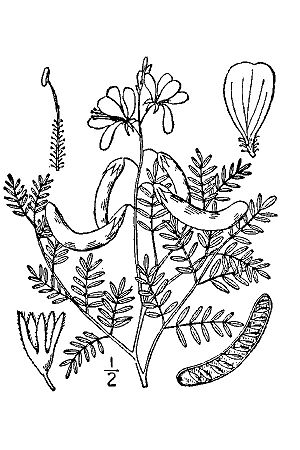Pig-nut facts for kids
Hoffmannseggia glauca is a special type of plant. It belongs to the Fabaceae family, which is also known as the legume family. This family includes plants like peas and beans. People often call this plant by other names, such as Indian rushpea, hog potato, or pig nut.
Quick facts for kids Pig-nut |
|
|---|---|
 |
|
| Scientific classification | |
| Kingdom: | |
| (unranked): | |
| (unranked): | |
| (unranked): | |
| Order: | |
| Family: | |
| Genus: |
Hoffmannseggia
|
| Species: |
H. glauca
|
| Binomial name | |
| Hoffmannseggia glauca (Ortega) Eifert
|
|
| Synonyms | |
|
|
Contents
Where Does It Grow?
This plant is originally from California. It likes to grow in certain places. These include alkaline desert flats and areas with creosote bush plants. It also grows well in places where the ground has been disturbed.
Hoffmannseggia glauca prefers to grow at lower elevations. It is usually found below 900 meters (about 2,950 feet) high. Besides California, you can find this plant in Western Nevada, Texas, Mexico, and South America. In California, it grows in the San Joaquin Valley, Southern Coastal Ranges, and Western Transverse Ranges.
What Does It Look Like?
Hoffmannseggia glauca is a plant that stands upright. It is a perennial herb, meaning it lives for more than two years. It can grow up to 30 centimeters (about 12 inches) tall.
Stems and Leaves
The plant has thin branches that grow from its base. These branches have special glands on stalks. Its leaves are compound, meaning they are made up of smaller leaflets. There are primary leaflets (5–20 mm long) and secondary leaflets (4–6 mm long).
Flowers and Fruit
The plant's flowers grow in a cluster called an inflorescence. This cluster is 5–15 centimeters long and also has glands. The flowers are orange-red with petals that spread out. They bloom between April and June.
After the flowers, a fruit develops. This fruit is 1.5–4 centimeters long. It is also glandular, curved, and has a short stalk. Sometimes the fruit falls off the plant, and sometimes it stays attached.
Is It a Problem Plant?
The USDA says that Hoffmannseggia glauca is considered a noxious weed in Kansas. A "noxious weed" is a plant that can be harmful to crops, natural areas, or livestock. This means it might grow too much and cause problems for other plants or farming in Kansas.
How Was It Used?
Long ago, several Native American tribes used this plant. The Pima, Apache, Cocopa, and Pueblo peoples ate the plant's tubers or bulbs. They would eat them raw, boil them, or roast them.
Images for kids


